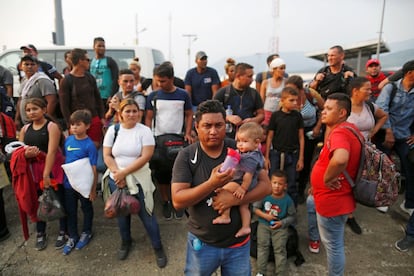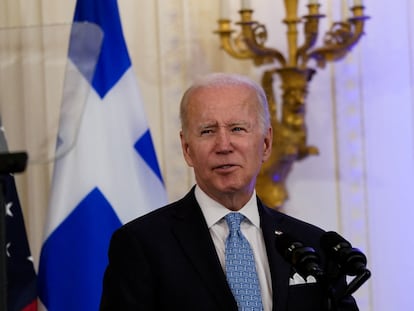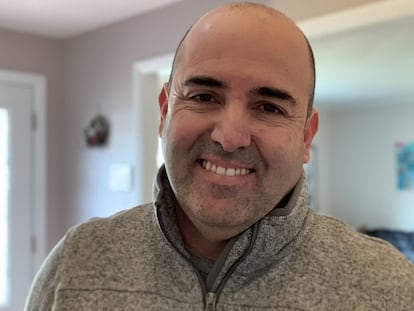US to resume granting 20,000 visas to Cubans each year
Family reunification will be prioritized, while the embassy will ‘expand consular services’ and increase its staff ‘as conditions permit’

High-level officials from Cuba and the United States held talks this week in Havana on migratory issues, as a first step to reopening US consular services on the island.
The Trump administration suspended these services five years ago, while curtailing Cuban immigration from 2017 until 2021. Under existing immigration agreements, Washington must grant at least 20,000 visas to Cuban immigrants each year. However, according to the Cuban authorities, for the entirety of the Trump administration and for the first half of the Biden administration, only an average of 4,000 visas have been granted annually.
Rena Bitter – Assistant Secretary of State for Consular Affairs – and Ur Mendoza Jaddou – the Director of Citizenship and Immigration Services at the Department of Homeland Security – are the two highest-ranking American officials to visit Cuba since President Joe Biden began his term. It’s no coincidence that they made the trip in the midst of a migration crisis in the Americas.
Over the last fiscal year, around 224,000 Cubans entered the United States irregularly over the Mexican border. An additional 6,000 were intercepted by the US Coast Guard as they attempted to reach American soil via raft. In September of this year, Cuba and the United States held what was described as a “technical meeting” in Havana between Cuban Border Guard officials and the US Coast Guard Service to “increase bilateral cooperation” in the fight against irregular immigration.
Assistant Secretary Bitter and Director Mendoza were received on November 10, by a Cuban delegation headed by the Vice Minister of Foreign Affairs, Carlos Fernández de Cossío, who, according to an official statement, “reiterated the importance of fully resuming the migration services and consular services at the US Embassy in Havana, including the processing of non-immigrant visas.”
The US embassy has reported that Washington will resume the “complete processing of immigrant visas as of January 4, 2023.” Family reunification will be prioritized, while the embassy will “expand consular services” and increase its staff “as conditions permit.”
In a press release, the embassy noted that, during the talks, Assistant Secretary Bitter “expressed her concern to Cuban officials about the human rights situation and urged the government to unconditionally release all political prisoners.” Cuba, for its part, stressed that the US embargo must be lifted. The regime claims that it is the main cause of worsening living conditions in Cuba and is a trigger for irregular emigration.
In 2017, under the mandate of former-president Donald Trump, the US embassy reduced its staff to a minimum, on the grounds of mysterious “sonic attacks” being directed against its diplomats – something that Havana always denied. Scientific investigations carried out by the United States have been inconclusive. According to the Cuban government, the alleged “sonic attacks” were only a pretext to dismantle the embassy as “part of a political operation to reverse advances in relations between Cuba and the United States during the administration of President Barack Obama.”
Since then, consular operations have been practically paralyzed. Cubans who are candidates for emigration have had to travel to Guyana to carry out procedures to legally enter the United States.
During Trump’s term (2017-2021), the United States tightened the embargo policy and included the island on a list of state sponsors of terrorism. This resulted in fewer imports, drastic cuts in American tourism and cruise ships, as well as the end of the ability of Cuban-Americans to send remittances to their loved ones. All of this suffocated the already-fragile state-controlled Cuban economy.
During the 2020 America presidential campaign, Biden advocated a return to Obama’s “constructive engagement” policy toward Havana. Yet, upon taking office, he has been very cautious in his dealings with Cuba, for fear of provoking outcry from Republicans, Cuban-Americans and many Venezuelan immigrants, who were driven out of their country by the policies of a Cuban-backed regime. Since 2021, he has only eased some of the sanctions – on remittances, flights and some types of trips – although the dialogue between the two countries has advanced at a snail’s pace.
However, the official talks on immigration issues – suspended by Trump – resumed in 2022. The last meetings were held in Washington, D.C. in April, followed by officials from the US Coast Guard Service travelling to Havana in September. There has also been bilateral contact on collaboration to prevent fuel spills that could impact both countries’ territorial waters.
For the first time, after the devastation caused by Hurricane Ian in September 2022, the Cuban regime accepted humanitarian aid worth $2 million from USAID – the US Agency for International Development – which the Communist Party in Havana has always accused of fomenting subversion on the island. Before that, during summer fires, the US sent uniforms and equipment to Cuban firefighters. Now, in the midst of an unprecedented migration crisis – which has already surpassed the Cuban exodus in the 1980s and 90s – both countries are meeting to see what else they can find common ground on.
Tu suscripción se está usando en otro dispositivo
¿Quieres añadir otro usuario a tu suscripción?
Si continúas leyendo en este dispositivo, no se podrá leer en el otro.
FlechaTu suscripción se está usando en otro dispositivo y solo puedes acceder a EL PAÍS desde un dispositivo a la vez.
Si quieres compartir tu cuenta, cambia tu suscripción a la modalidad Premium, así podrás añadir otro usuario. Cada uno accederá con su propia cuenta de email, lo que os permitirá personalizar vuestra experiencia en EL PAÍS.
¿Tienes una suscripción de empresa? Accede aquí para contratar más cuentas.
En el caso de no saber quién está usando tu cuenta, te recomendamos cambiar tu contraseña aquí.
Si decides continuar compartiendo tu cuenta, este mensaje se mostrará en tu dispositivo y en el de la otra persona que está usando tu cuenta de forma indefinida, afectando a tu experiencia de lectura. Puedes consultar aquí los términos y condiciones de la suscripción digital.










































